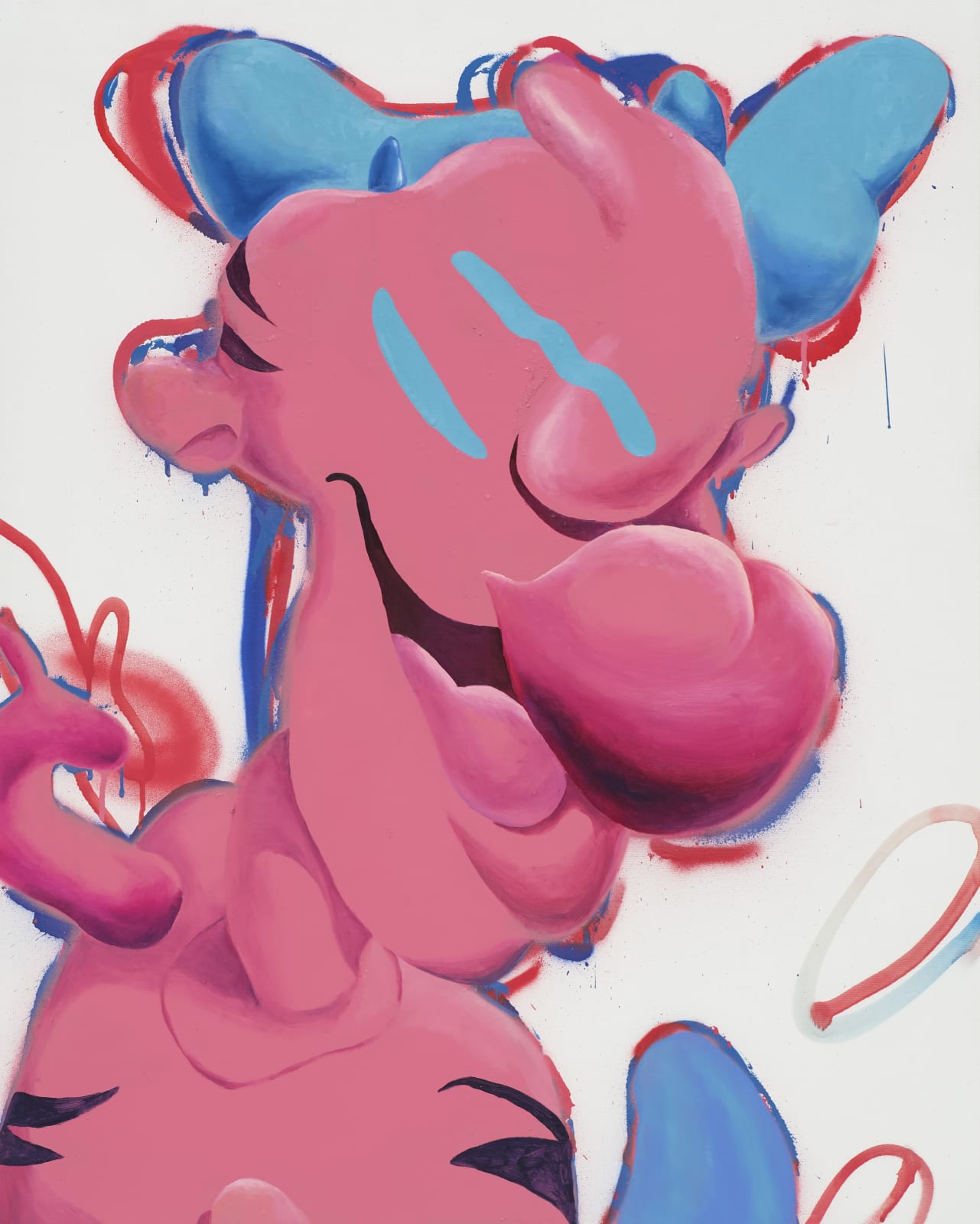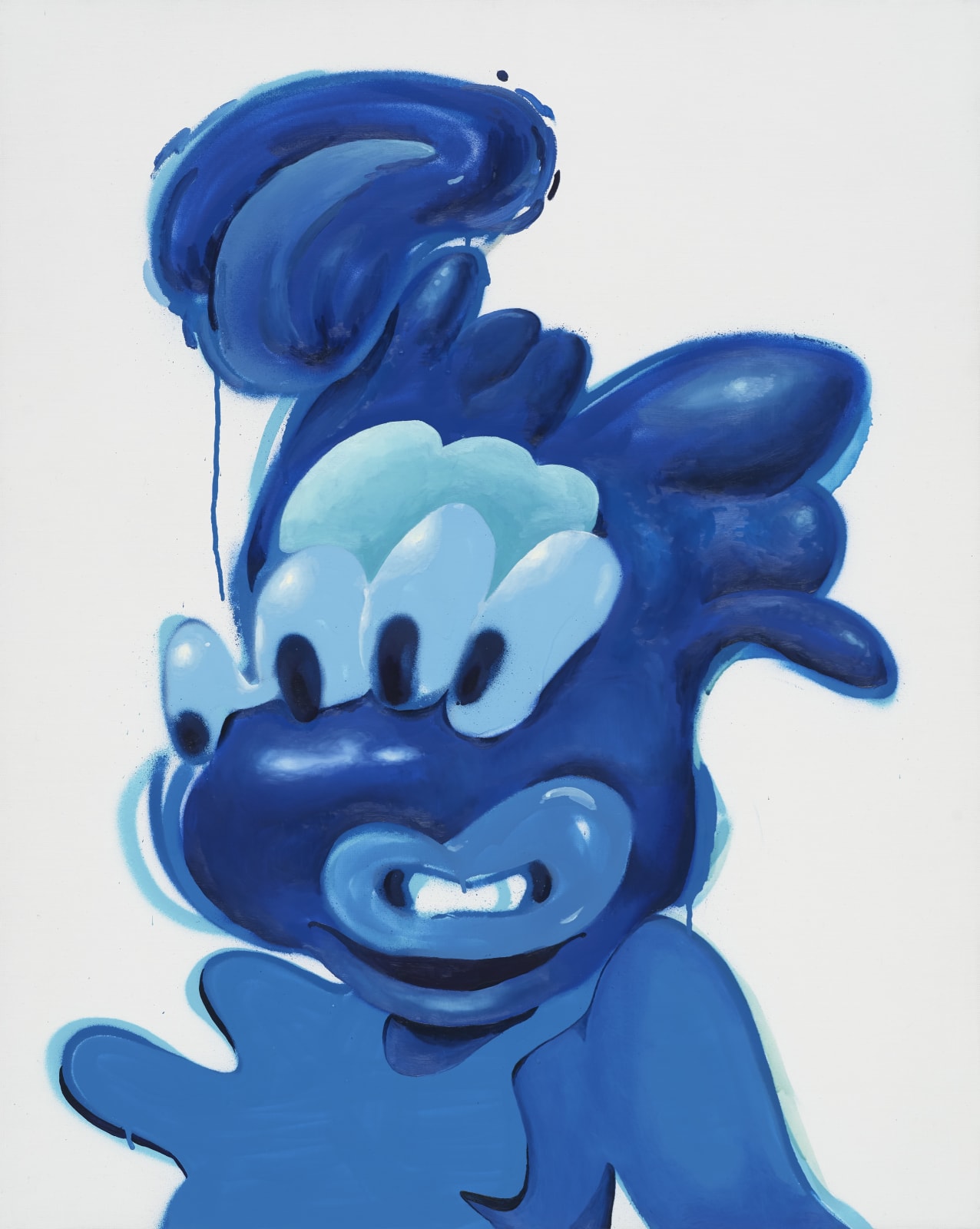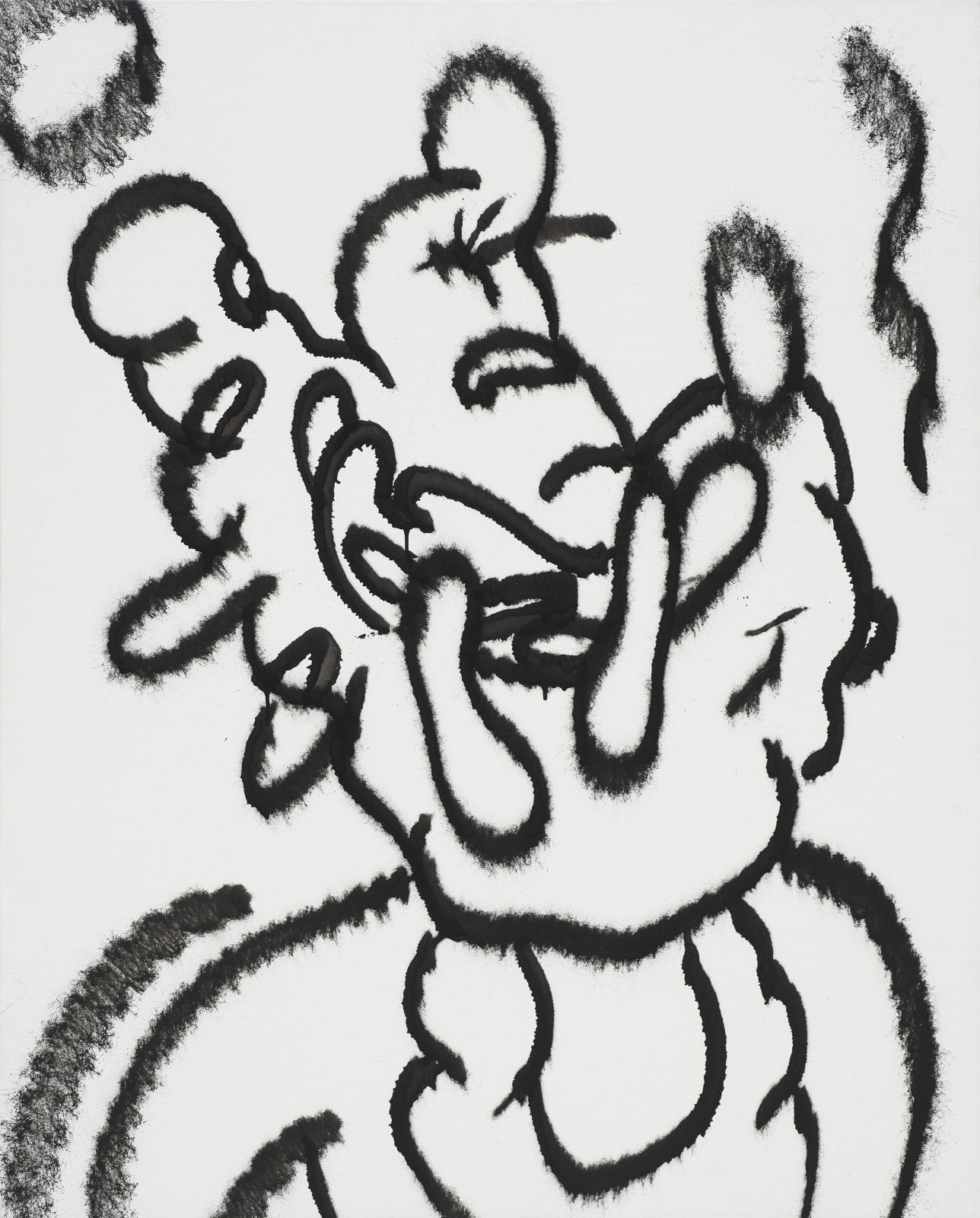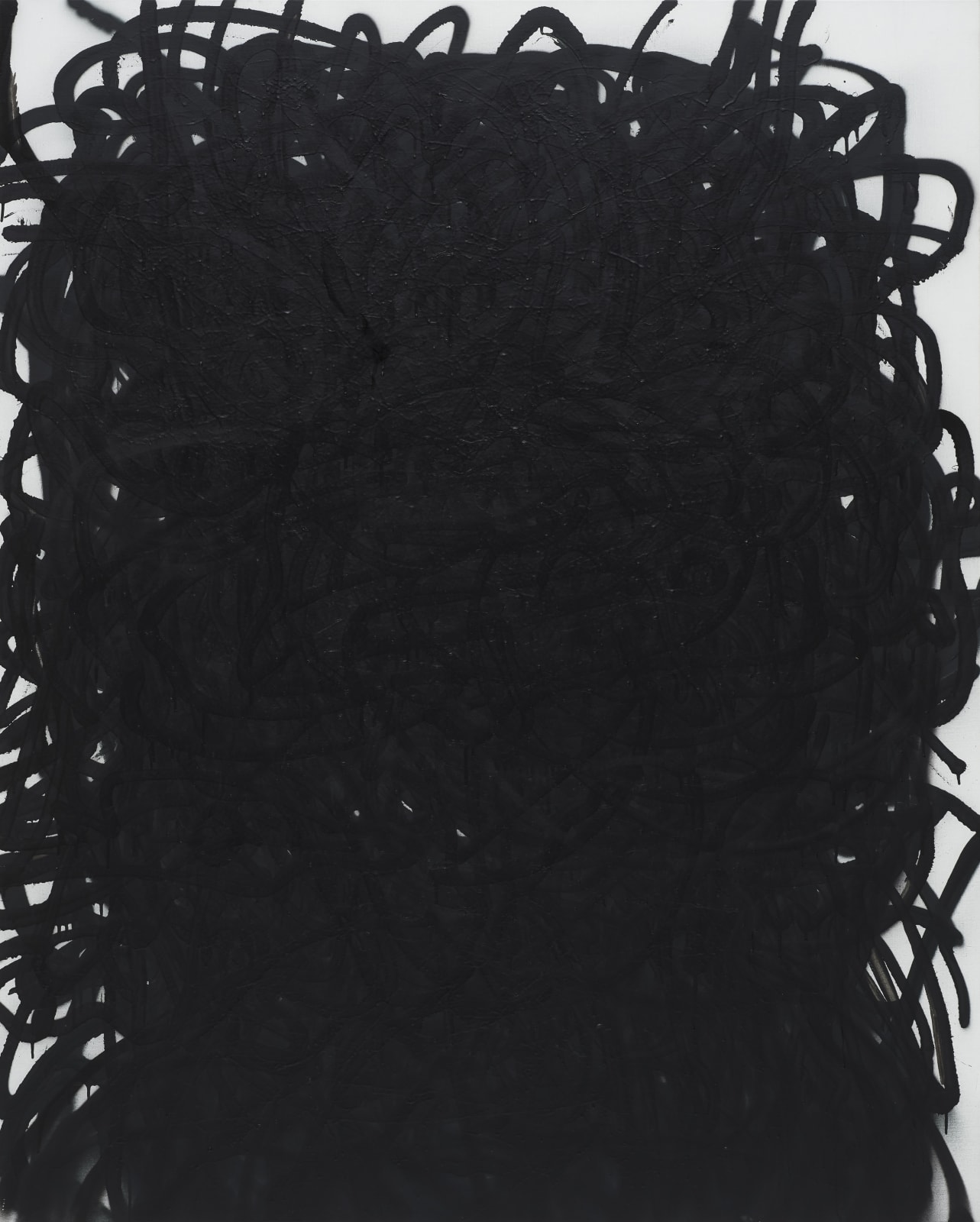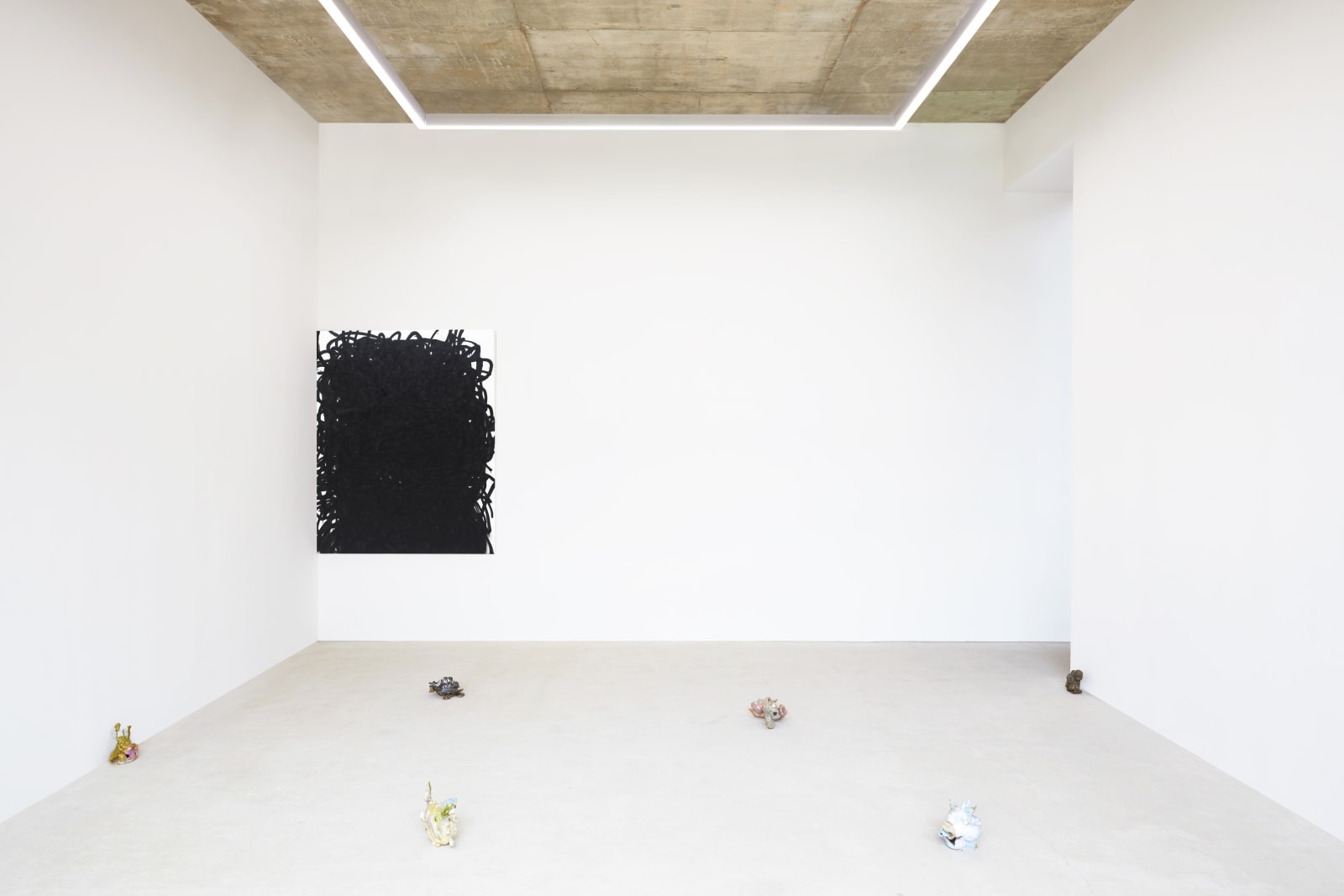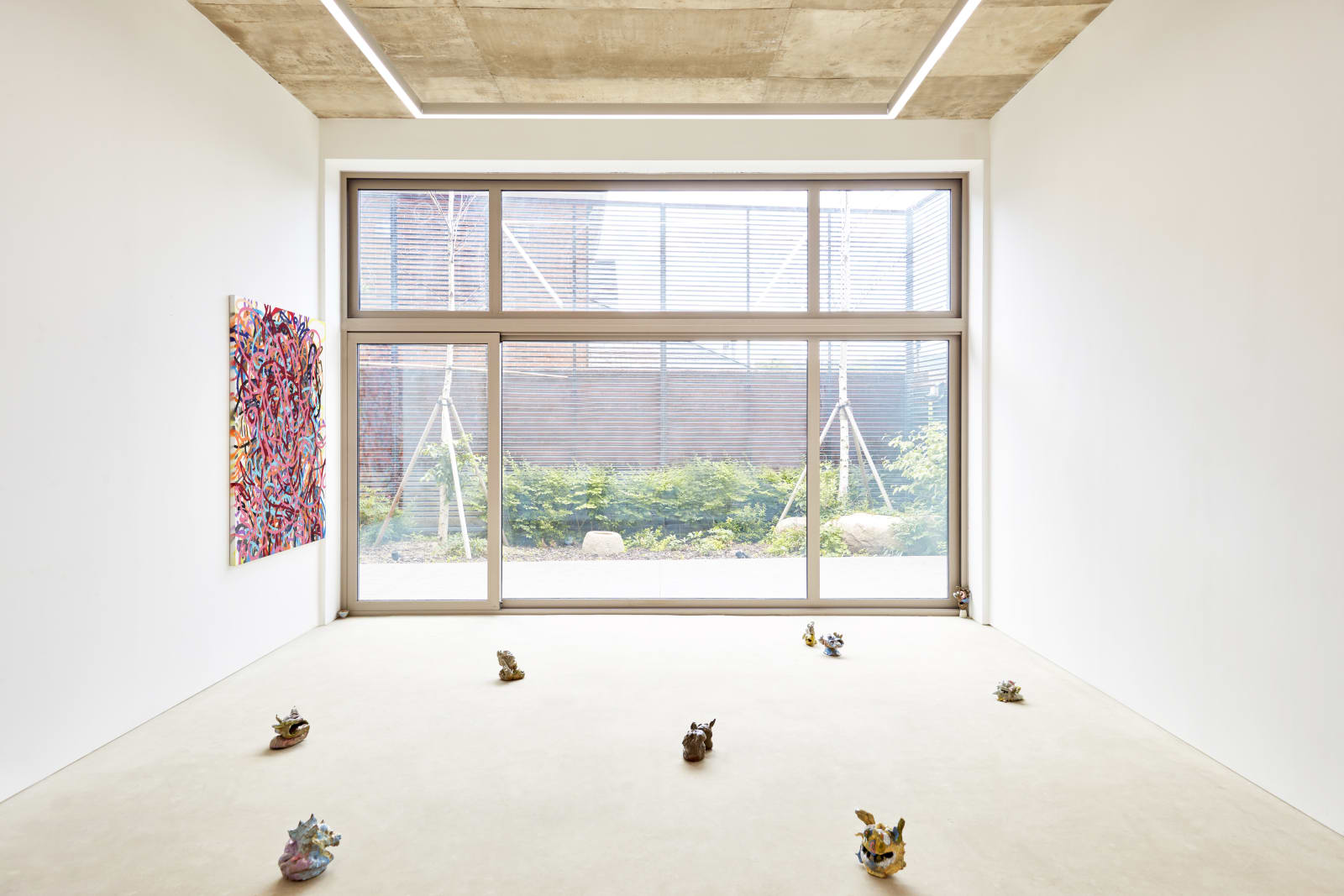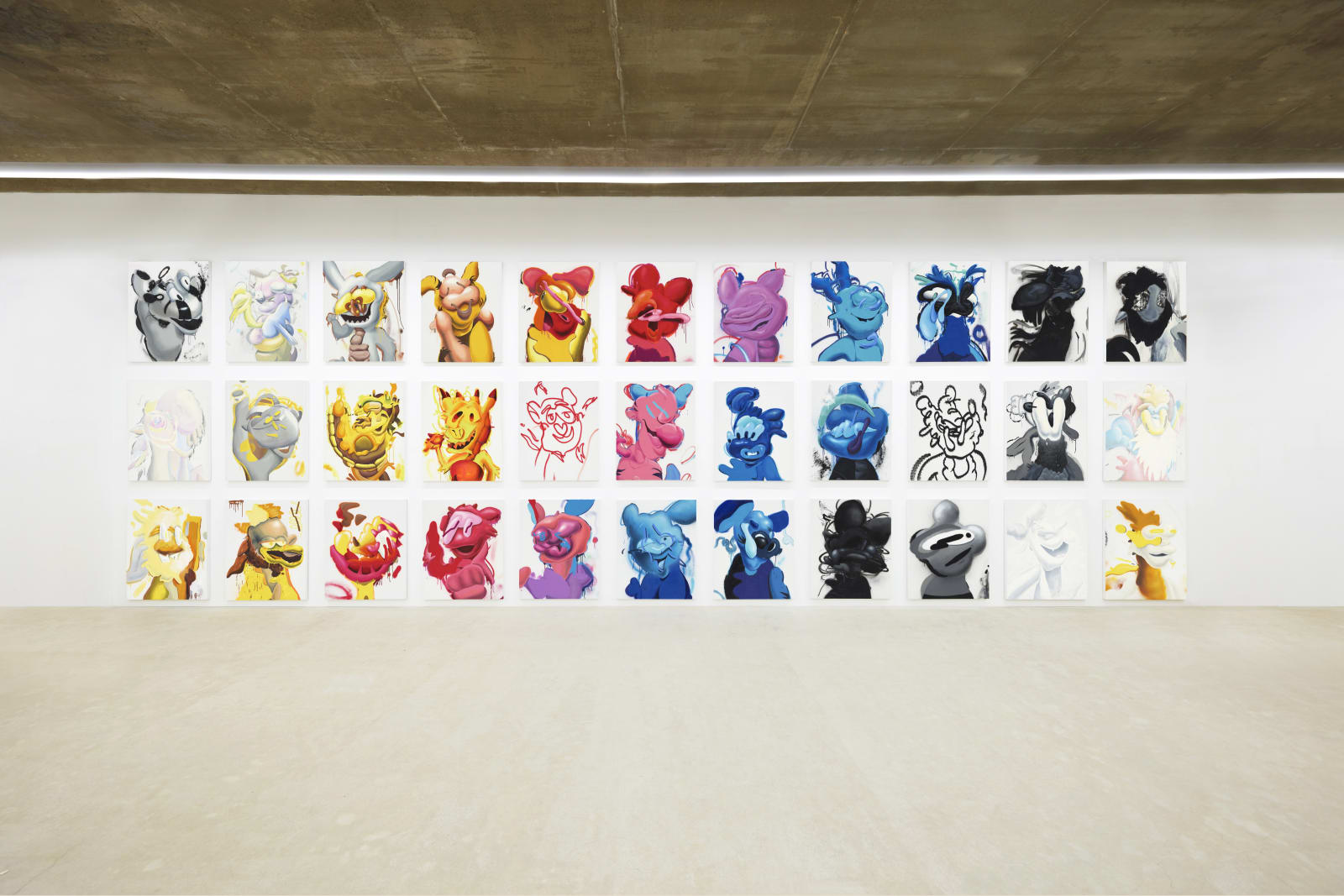Mashed Potato: 이해강 Haekang Lee
질서는 연속적이고 고정되지 않는 흐름을 뚜렷한 한 묶음의 전체적인 것으로 만드는 작업이다. ‘묶는다’는 것은 결국 경계를 짓는 것이며 여기서 경계 안의 ‘나/우리’와 경계 밖의 ‘너/그들’의 관계가 형성된다. 경계에 대한 감수성이야말로 우리가 질서를 앞세운 세계에서 잃어왔던 것이다. 경계에서는 다의적이며 모순된 두 가지가 동시에 나타날 수 있다. ‘이름 붙일 수 없는’ 이미지와 상징이 끊임없이 출현하고 증식하며 새로운 통합을 완수한다.
이해강은 이번 개인전에서 연속되는 33점의 그림을 선보인다. 사실 무엇을 그린 것인지 알아보기 어려운 형상이다. 운이 좋으면 눈, 코, 입 정도의 형태는 찾아낼 수 있을 것이다. 그는 아시아에서 나이를 상징하는 12간지 동물을 소재로 했다. 12간지는 쥐-소-호랑이-토끼-용-뱀-말-양-원숭이-닭-개-돼지가 1년 단위로 변화하고, 청색-적색-황색-백색-흑색의 5가지 색이 2년마다 한 번씩 바뀐다. 해마다 고유한 동물과 색이 결정되는 것이다. 그런데 우리가 작품의 형상을 알아볼 수 없는 이유는 그림마다 12간지의 동물이 개별적으로 그려진 것이 아니라, 연속되는 두 동물과 그들의 고유색이 섞여 있기 때문이다. 예를 들어 그림이 시작하는 <BHWS02>는 2002년 말띠(흑색)와 2001년 뱀띠(백색)가 공존한다.
왜 이해강은 정확하게 1년의 주기를 상징하는 12간지의 동물을 일부러 결합한 것인지 질문하지 않을 수 없다. 그는 ‘빠른 연생’을 그림의 주인공으로 만들고 싶었다고 한다. 빠른 연생은 서열을 중시하는 한국 사회에서 ‘경계자’ 혹은 ‘중간자’다. 빠른 연생을 기준으로 본다면 이해강의 작품에서 보이는 2002년 말띠부터 1969년 닭띠가 모두 친구가 된다. 이렇게 경계를 모호하게 만들고 두 가지의 요소를 통합시켜버리는 것이 빠른 연생의 힘이다. 질서를 위협하고 혼란을 일으켜 수직적 관계를 수평적인 관계로 비약시킬 수 있는 존재인 것이다.
그림 속 12간지는 모두 월트디즈니에 등장하는 캐릭터들이다. 쥐는 미키마우스, 개는 구피, 호랑이는 티거, 돼지는 피그렛 등 대중적으로 익숙한 이미지를 사용했다. 하나의 형태가 다른 형태로 변하는 애니메이션 기법(모핑 기법, Morphing)을 통해 두 동물의 특징이 결합된 이미지가 만들어졌다. 직접 드로잉한 월트디즈니의 캐릭터를 애니메이션으로 제작하고 한 동물에서 다음 동물로, 예를 들어 돼지(띠)가 개(띠)로 변하는 순간의 프레임을 추출했다. 선택된 이미지는 캔버스 위에 유화 물감과 스프레이 페인팅으로 대상을 묘사했다. 이해강은 디지털 프로그램을 통해 만들어진 이미지를 캔버스 위에 그려서 하나의 ‘덩어리’로 만들어 내고 싶었다고 한다.
모핑 기법을 통해 추출된 이미지는 도자기로 다시 한번 제작된다. 그림과 마찬가지로 이미지를 보고 흙으로 형태를 만들어 구워냈다. 추출된 12종의 이미지를 가지고 15점의 도자기 작업을 완성했다. 흙을 건조하고 초벌 작업 후 유약을 바른 뒤 재벌 과정을 거쳐 채색하고 다시 낮은 온도에서 구워냈다. 이해강에게 도자기 작업은 평면의 이미지를 캔버스 위에 덩어리로 만들어 내는 것을 넘어 ‘진짜’ 덩어리로 만들어내는 작업이었다.
이미지는 비물리적이고 상징적인 형식들의 집합이다. 이미지의 매체를 통해 비로소 물질화가 되는 것이다. 우리는 그림을 벽에 걸 수 있지만, 이미지를 벽에 걸 수 없다. 이미지는 캔버스나 흙처럼 물리적인 지지체가 없다면 세상을 떠다니는 유령 같은 존재일 뿐이다. 그래서 이미지는 그림에서 떨어져 나와 다른 매체로 전이될 수 있다. 모핑 기법을 통해 만들어낸 12간지의 이미지는 그림이나 도자기처럼 물리적인 작품 속에 표현되기를 기다리는 원형(原型)의 영역에 존재한다. 캔버스 위에 하나의 형상으로 탄생시키는 것과 더 나아가 입체물로 만들어 내는 것은 이미지에 살과 뼈를 붙여 육화 시키는 작업인 것이다.
이해강은 그래피티 라이터(Writer)이면서 애니메이션 제작자이고, 2014년부터는 캔버스에 그림을 그렸다. 그래피티, 애니메이션, 현대미술의 어떤 영역에도 치우치거나 안착하지 않고 경계를 오가며 활동하는 그가 바로 질서를 위협하는 경계자인 것이다. 이해강이 만들어낸 이미지는 거리의 벽과 스프레이 페인트, 디지털 프로그램, 캔버스와 안료 등 상황과 목적에 맞게 지지체를 이동한다. ‘이름 붙일 수 없는’ 경계자는 ‘이름 붙일 수 없는’ 이미지를 육화시킨다.
Creating order requires an undertaking of taking a continuous yet irregular flow and binding them into a distinct whole that shares a certain property. To bind is to create a boundary, a line between the me-us and you-them. In a world ruled by order, our acute awareness of boundaries became obtuse. Boundaries are ambiguous, and may even be ambivalent. Ineffable images and symbols constantly emerge and proliferate, drawing more lines in the sand.
In his latest solo exhibition, Lee Haekang presents 33 works that he intends to be viewed in succession. What he has painted is not immediately clear. If you are prone to pariodolia (tendency to identify vague stimulus as something known to the observer), then the prosopagnosia (inability to recognize facial features) of these 33 paintings may not hide all the noses, eyes, and mouths. Lee draws from the twelve animals of the Chinese zodiac. People from East Asia often refer to one of the animals instead of giving a number for their age. Every year, the Chinese zodiac rotates through the rat-ox-tiger-rabbit-dragon-snake-horse-goat-monkey-rooster-dog-pig. The astrology also assigns a new color every other year, from blue-red-yellow-white-black. That is to say, each a year has an animal and a color that goes with it, and it takes 60 years to get the same animal and color. The reason Lee's works are not easily recognizable is because the artist painted the beasts adjacent on the cycle together on the canvas with both their designated colors. For example, the first in the series is <BHWS02>, which is combines the horse (2002, black) and the snake (2001, white).
This begs the question, why did Lee go through such elaborate and deliberate lengths to combine the twelve animals of the zodiac? Lee explains that he wanted his works to feature the people "born early in the year", or the "earlies"[1]. This system isn't strictly followed and causes for some awkward situations when the year and date of birth is brought to light in social circles. In Korean society where pecking order is no laughing matter, those born early in the year are often "riding the fence" or "on the border". Take this theme of blurring boundaries to an extreme and, you can make everyone born between 2002 (horse) and 1969 (rooster) peers and friends. This blurring of boundaries and fusing of separate elements is the power inherent in the earlies. The earlies have the ability to shake the established order, instigate chaos, and topple a vertical relationship into a horizontal one.
The twelve animals of the zodiac that the artist started with are all characters borrowed from Disney's animated works. Mickey Mouse, Goofy, Tigger, Piglet, and other popular and recognizable characters are featured here. Morphing, an animation technique where two varied images are blended into one, was used to combine an image that carries the characteristics of both animals. Lee hand-drew and animated the Disney characters, morphed the characters together, then extracted the appropriate intermediary frame when one animal was morphing into the other in form not clearly distinguishable. Once he saw the image he wanted, he painted it on canvas using oils and spray paint. Lee explains that he wanted to create a bind of sorts, by transposing a digitally-generated image on canvas.
The images derived from morphing is then give volume in the medium of clay. Similar to his works on canvas, he looks at the image and transposes it onto the medium. Lee created 15 pottery clay figures using 12 of the images that he morphed. After drying the clay, applying the primer and glaze, the figures were baked repeatedly, the colors added then baked one last time at low temperature. For the artist, working with pottery clay was a means to go beyond the bind on canvas and push as much as possible into the realm of reality.
Images are a collection of non-material, metaphorical forms. It is the medium of the image that gives it materiality: a painting can be hung on the wall, but an image cannot be hung anywhere. Without the physical substrate of canvas or pottery clay, images would be mere apparitions, floating around the ethereal. That is, images are not free to simply transfer over to other substrates. The twelve morphed images of the zodiac animals exist in the realm of archetypes, waiting to be expressed upon a substrate of art, upon paintings or clay. Creating a figure on canvas, then creating a three-dimensional figure in space is in itself an act of incarnating image with flesh and bone.
Lee Haekang is a graffiti writer, an animation producer, and from 2014 onwards has been creating on canvas. He sails over boundaries into graffiti, animation, and any medium and genre of contemporary art without dropping anchor. He is the one who threatens the order of boundaries by standing on the line. Images that Lee Haekang create move across substrates to best fit the situation and purpose; spray paint, alleyway walls, digital programs, canvas and dye. The ineffable border-rider incarnates the image that is in turn, ineffable.
[1] the Korean age system unofficially calculates January and February as part of the preceding year, often adding an extra year to children born in January of February
